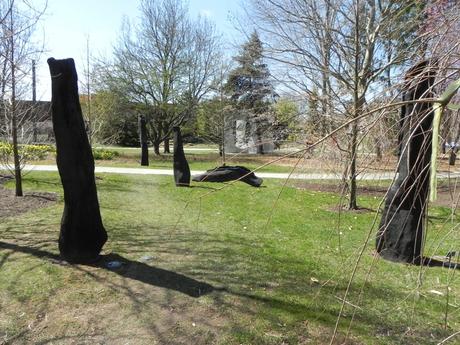After being removed from academia, my work on Asherah started to receive notice. You see, I’m not part of some academic dynasty and I never landed that prestigious job that would convince people I had something worthwhile to contribute. Besides, it turned out that several other scholars were writing books on Asherah at the same time I was. The subject, however, has proven “evergreen.” Asherah holds a lot of explanatory power, it seems. She solves mysteries like an antique Holmes or Dupin. And the Bible is full of mysteries. The other day I saw an article by Raanan Eichler suggesting that Aaron’s rod might’ve been an asherah. This is an intriguing idea. In case your Exodus is a bit rusty, there are two staffs (or staves, if you prefer) that feature in, well, the exodus. One belongs to Moses and the other to Aaron. (Keep in mind that they were octogenarians when they began the trek.) Their stories continue through Deuteronomy.
 Tova Beck-Friedman ‘s “Excerpts of a Lost Forest: Homage to Ashera,” Grounds for Sculpture
Tova Beck-Friedman ‘s “Excerpts of a Lost Forest: Homage to Ashera,” Grounds for Sculpture
In the narrative sometimes the stick is Aaron’s and sometimes it belongs to Moses. It transforms into a snake, it turns dust into biting gnats, it divides the Reed Sea. In short, it’s the kind of staff you’d see advertised as a miracle-working purchase on infomercials these days. One of its many features is that it produces water from a rock when it strikes said stone. The problem is God had told Moses to be a stone-whisperer, not a stone-striker. Because he hits the rock with the staff he’s barred from entering the promised land. It seems like harsh punishment for a bit of dramatic flair and I suspect that’s why Eichler suggested that the staff was an asherah.
Of course, the biblical account doesn’t use the word “asherah” for the staff at all. Although it accompanies the Israelites through the wilderness, and in some accounts is placed inside the ark of the covenant, it isn’t called an “asherah.” But being in the ark puts it into the tent of meeting, and therefore later the temple. And we do find an asherah in the temple later in the biblical story. The thing about asherim is that they’re never defined in the Good Book. We simply don’t know what they were. They were made of wood and they could’ve been poles. They might’ve been trees or statues. A rod or staff seems to be a slimmed-down version of a full-blown pillar, so who knows? Maybe an asherah accompanied Israel from the beginning. Of course, being outside the academy (my own promised land), I’ll never know for sure.
